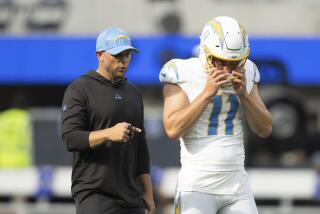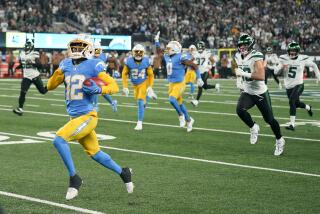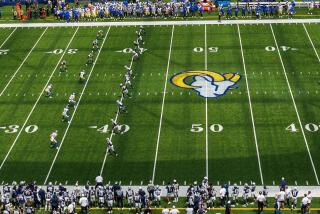New rule could mean more returns, injuries
It was last winter when NCAA football officials gathered to discuss making games faster-paced and more exciting. As one official put it, they wanted to “chip off the dead time.”
Someone suggested doing away with kickoffs, having teams start each possession from the 20-yard line. Instead, the NCAA rules committee took the opposite approach.
With the season beginning this week, college football will be under scrutiny for a rule change that pushes kickoffs back five yards to the 30-yard line. The logic: Five more yards should equal more room for returns, more thrills and more time running off the clock.
But that kind of excitement also has some coaches scrambling to reshuffle their special teams and others wondering if the game just got more dangerous.
“There are going to be more returns,” Oregon Coach Mike Bellotti said. “So there will be more high-speed collisions.”
This is not the first time the NCAA has addressed the issue of games stretching well past three hours in length. Various clock rules instituted in 2006 proved successful in trimming minutes but were highly unpopular and revoked after the season.
Officials turned their attention to the touchback, a relatively dull play that also wastes time because the clock never starts. The NFL had already switched its kickoffs to the 30-yard line.
It remains to be seen how the new rule will affect the flow of college play.
The Pacific 10 Conference does not keep statistics on how often kickoffs are returned. In the Southeastern Conference, about a third of kickoffs resulted in a touchback last season.
Florida Coach Urban Meyer said his staff looked at game film and predicted many returners will catch the ball around the nine-yard line and head upfield from there.
“That’s when you start talking about the field position, opportunity to score, percentages to score, things that most teams take very serious,” Meyer said. “It’s going to have a major impact.”
The pressure will be on kickoff squads to adapt. That could mean more directional kicks, more pooches and squibs. It could also mean that defensive starters find themselves playing special teams.
“You’ve got to have different guys,” Auburn Coach Tommy Tuberville said. “You’ve got to have better cover guys on your coverage team.”
Dr. Elton Strauss, chief of orthopaedic trauma at the Mount Sinai School of Medicine in New York, predicts that the brutal physics of the kickoff -- players working up a head of steam, bodies hurtling downfield -- will increase injuries on both sides of the ball. “When a defensive team picks up more speed, it’s kind of like a high-velocity rocket,” Strauss said.
Knees and ankles are most at risk. There might also be an increased chance of concussions and catastrophic spinal cord injuries related to tacklers flying into a ballcarrier with their heads down, he said. According to the NCAA, kickoffs and kick returns accounted for approximately 8% of football injuries from 2004 to 2007. By comparison, running plays accounted for 44% and pass plays for 28%.
Ron Courson, the head trainer at Georgia, says he wants to see more data before passing judgment on the new rule. Still, officials recognize that kickoffs can be particularly violent and will monitor injuries this season.
“I think most people are willing to take a good look at it,” said Dave Parry, the NCAA’s football officiating coordinator. “Let’s give it a chance.”
UCLA Coach Karl Dorrell said he isn’t too concerned about increased injuries. With his Bruins opening their season Saturday at Stanford, he was more interested in talking about the flip-side of the new rule. “You’ve got a chance to make some plays,” he said. “You can get your offense in good position.”
--
More to Read
Go beyond the scoreboard
Get the latest on L.A.'s teams in the daily Sports Report newsletter.
You may occasionally receive promotional content from the Los Angeles Times.











